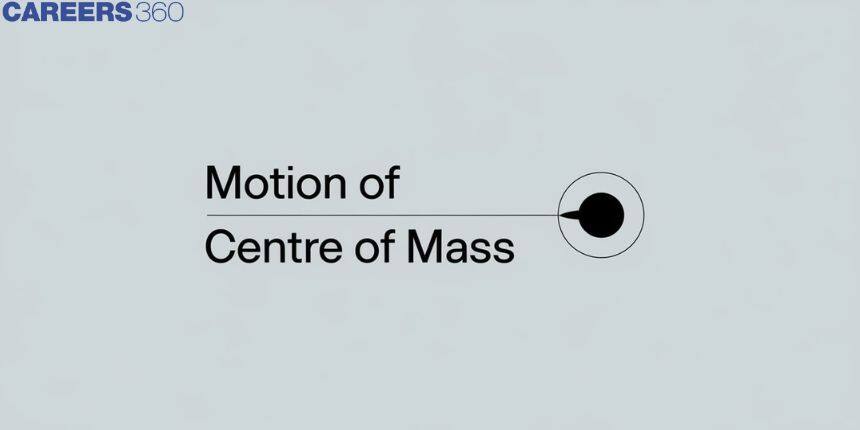Motion of Centre of Mass
Assume for the moment that the place at which the mass of a body or system of bodies is meant to be concentrated during its entire motion is known as the centre of mass. Another way to put it is that the mean location of mass distribution in space where the force is typically applied is the average position of all the system components, leading to a linear acceleration devoid of any rotational acceleration. The body's or system's condition of motion or rest will not change if an external force is applied to the centre of mass of the body or system of bodies.
JEE Main/NEET 2027: Physics Important Formulas for Class 10
NEET 2025: Mock Test Series | Syllabus | High Scoring Topics | PYQs
JEE Main: Study Materials | High Scoring Topics | Preparation Guide
JEE Main: Syllabus | Sample Papers | Mock Tests | PYQs
- Velocity of the Centre of Mass
- Solved Examples Based On Motion of the Centre of Mass
- Summary

In this article, we will cover the concept of velocity of the centre of mass and acceleration of the centre of mass under the topic of motion of the centre of mass. This topic falls under the broader category of Rotational Motion, which is a crucial chapter in Class 11 physics. It is not only essential for board exams but also for competitive exams like the Joint Entrance Examination (JEE Main), National Eligibility Entrance Test (NEET), and other entrance exams such as SRMJEE, BITSAT, WBJEE, BCECE and more. Over the last ten years of the JEE Main exam (from 2013 to 2023), more than five questions have been asked on this concept. It's also an important topic from NEET's point of view.
Let's read this entire article to gain an in-depth understanding of the motion of the centre of mass.
Velocity of the Centre of Mass
where:
Similarly momentum of the system
Acceleration of Centre of Mass
Similarly Net force on the system
And
And we know that both the action and reaction of an internal force must be within the system. In this way, vector summation will cancel all internal forces and hence net internal force on the system is zero.
So
If the External Force
if
If
So it implies that the total momentum of the system must remain constant.
i.e. if no external force is acting on the system, the net momentum of the system remains constant. This is nothing but the principle of conservation of momentum in the absence of external forces. Which says ìf the resultant external force is zero on the system, then the net momentum of the system must remain constant.
Special Case
If External Force = 0 and Velocity of Centre of Mass = 0
The centre of mass remains at rest. Individual components of a system may move and have non-zero momentum due to mutual forces but the net momentum of the system remains zero.
Recommended Topic Video
Solved Examples Based On Motion of the Centre of Mass
Example 1: identical particles move towards each other with velocities 2v and v respectively. The velocity of the centre of mass is :
1)
2)
3)
4) zero
Solution:
Hence, the answer is option (3).
Example 2: The arrangement of two masses

1) g/2
2) g/3
3) g/4
4) g
Solution:
Acceleration of centre of mass -
- wherein
acceleration of system
The magnitude of acceleration of the centre of mass is

Example 3: A body A of mass
1) body
2) body B
3) depends on the height of the breaking
4) does not shift
Solution:
If External Force = 0 and Velocity of Centre of Mass = 0
The centre of mass remains at rest. Individual components of a system may move and have non-zero momentum due to mutual forces but the net momentum of the system remains zero.
The centre of mass of bodies B and C taken together does not shift as no external force is applied horizontally.
Hence, the answer is option (4).
Example 4: A man of mass 80 Kg stands on a plank of mass 40 Kg. The plank is lying on a smooth horizontal floor. Initially, both are at rest. The man starts walking on the plank towards the north and stops after moving a distance of 6m on the plank. The plank will move
1) 6m, south
2) 4m, north
3) 4m, south
4) 6m, north
Solution:
As we have learned
If External Force = 0 -
wherein
i.e. if no external force is acting on the system, the net momentum of the system remains constant.
As

Example 5: A projectile of mass M is fired so that the horizontal range is 4 Km. At the highest point, the projectile explodes in two parts of masses M/4 and 3M/4 respectively and the heavier part starts falling down vertically with zero initial speed. The horizontal range (distance from the point of firing )of the lighter part is :
1) 16 Km
2) 1 Km
3) 10 Km
4) 2 Km
Solution:
Hence, the answer is the option 3.
Summary
The forces that the system's particles apply to one another are known as internal forces; but, according to Newton's third rule, these internal forces only exist in pairs that are equal in magnitude and directed in opposing directions. Thus, they have a zero net sum.
Newton’s third law states that for every action, there is an equal and opposite reaction; therefore, the gravitational forces between them are identical in magnitude but opposite in direction.
Also Read
05 Feb'25 04:39 PM
25 Dec'24 10:26 AM
29 Nov'24 08:18 PM
29 Nov'24 11:02 AM
13 Nov'24 09:48 AM
12 Nov'24 11:22 PM
11 Nov'24 05:38 PM
11 Nov'24 11:37 AM
26 Sep'24 11:20 AM
26 Sep'24 11:12 AM

